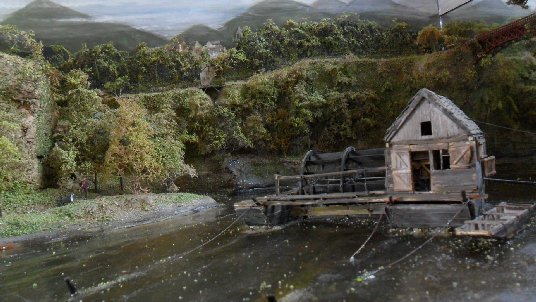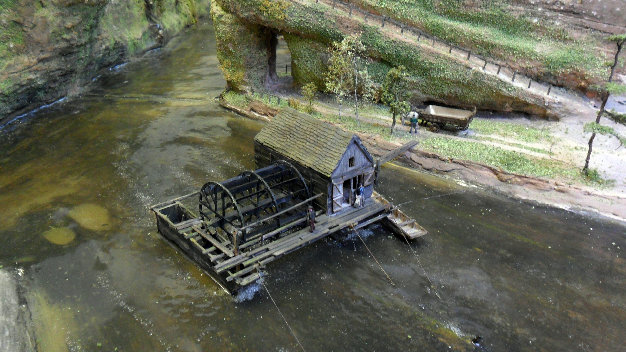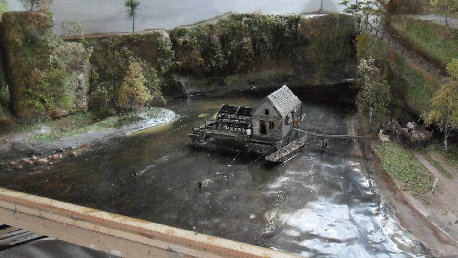


BOATMILL OR SHIP MILL
A boat mill is basically a floating watermill, once common in many parts of Europe but noticeably absent from Great Britain although records show there were several attempts to establish them on the river Thames in London and the last one was removed in 1811 after several accidents with other shipping. Unfortunately there seems to be no surviving contemporary engravings to show how they may have looked.
On large rivers such as the Rhine, Danube,Elbe and their many tributaries boat mills were once a common sight, often situated near large towns or cities several would be in sight of each other in a line along the river bank. Millers had their own communities and were thus able to help each other with repairs & protection from storms.
The preference for a boat mill rather than a land based mill had many advantages, although the initial cost was high for a boat mill - it still contained exactly the same mechanisms as a land based mill but it also included the boats it floated on, however it did not involve the construction of a leat or millpond and there was little likelihood of a large river drying up in summer & as the water levels started to drop then the boatmill could be moved to a more suitable position. Also there were no extortionate ground rents to pay other than the local river tax to the landowner
On large rivers such as the Rhine, Danube,Elbe and their many tributaries boat mills were once a common sight, often situated near large towns or cities several would be in sight of each other in a line along the river bank. Millers had their own communities and were thus able to help each other with repairs & protection from storms.
The preference for a boat mill rather than a land based mill had many advantages, although the initial cost was high for a boat mill - it still contained exactly the same mechanisms as a land based mill but it also included the boats it floated on, however it did not involve the construction of a leat or millpond and there was little likelihood of a large river drying up in summer & as the water levels started to drop then the boatmill could be moved to a more suitable position. Also there were no extortionate ground rents to pay other than the local river tax to the landowner
The mill could be positioned midstream which required access by boat for ferrying the grain & then flour back to the waiting cart, alternatively near to the bank where access by a boardwalk or gangplank was easier as depicted in the model shown here.
Most important of all was the need for a steady controllable flow of current which could power the often huge waterwheels - many of which were 6 metres in width & diameter.
The boats two hulls needed very secure anchoring to ensure they did not break loose, often the method used was to insert heavy posts angled towards upstream and hammered deep into the river bed on which to fix their chains, these often became a hazard to other boats, particularly if the mill had moved to another location & there are many reports of severe damage to other boats upon running into an abandoned anchor post. There were many disputes between boat millers & owners of freight barges who didn't consider millers to be classed as proper boatmen & there was often intense rivalry.
Most important of all was the need for a steady controllable flow of current which could power the often huge waterwheels - many of which were 6 metres in width & diameter.
The boats two hulls needed very secure anchoring to ensure they did not break loose, often the method used was to insert heavy posts angled towards upstream and hammered deep into the river bed on which to fix their chains, these often became a hazard to other boats, particularly if the mill had moved to another location & there are many reports of severe damage to other boats upon running into an abandoned anchor post. There were many disputes between boat millers & owners of freight barges who didn't consider millers to be classed as proper boatmen & there was often intense rivalry.


Unfortunately, boat mills were frequently involved in accidents of one kind or another. They were never built with any means of proper navigation, no tiller, no keel & should they break loose then they would be swept away downstream turning sideways and backwards until they either ran aground or worse still struck a bridge. Fire was another hazard due to their construction frequently being made entirely of wood, Bearings overheating - a problem common to all types of mill could result in a major fire if the miller was not attentive & being surrounded by water seemed to be of little help.
Another major hazard in the colder parts of Europe was winter ice breaking up,huge chunks would come hurtling down in the early Spring thaw & many mills were towed into Winter harbours where they were protected from the worst of the Winter flood.
Another major hazard in the colder parts of Europe was winter ice breaking up,huge chunks would come hurtling down in the early Spring thaw & many mills were towed into Winter harbours where they were protected from the worst of the Winter flood.
Little now remains of the original boat mills, a few managed to keep going right up till the 1960's and quite possibly one or two may still be in operation .
Although some of the German boat mills were huge superbly made craft with three floors complete with family accommodation they were more often than not quite crudely made with a single floor, parts constantly in water didn't last very long and the wheel itself would be expected to have it's main parts replaced within five years.
The planked hulls were often fixed together with iron clamps - like big staples - & the joints stuffed with moss which when wet swelled up & prevented leaks, a coating of tar also helped although rainwater frequently found it's way inside the hull which resulted in the boat rotting from the inside.
Boats in any given area were almost always of the same type, the tradition for a certain size & construction going back many generations with little variation.
There are some original boat mills preserved in outdoor museums & there are some modern reconstructions open for visitors.
Although some of the German boat mills were huge superbly made craft with three floors complete with family accommodation they were more often than not quite crudely made with a single floor, parts constantly in water didn't last very long and the wheel itself would be expected to have it's main parts replaced within five years.
The planked hulls were often fixed together with iron clamps - like big staples - & the joints stuffed with moss which when wet swelled up & prevented leaks, a coating of tar also helped although rainwater frequently found it's way inside the hull which resulted in the boat rotting from the inside.
Boats in any given area were almost always of the same type, the tradition for a certain size & construction going back many generations with little variation.
There are some original boat mills preserved in outdoor museums & there are some modern reconstructions open for visitors.
The model is based on a typical type of boat mill ( also known as ship mill ) such as would have been found in Romania and Hungary on small tributaries of the river Mures such as the river Aries.
The scale of the model however does not permit a wider expanse of water as a more typical location for a boat mill
The scale of the model however does not permit a wider expanse of water as a more typical location for a boat mill

The model shown near to completion
The finished model
Above: Looking down on the model showing the realistic water effect
You can see more pictures showing how this boat mill diorama was made
1/96th Scale